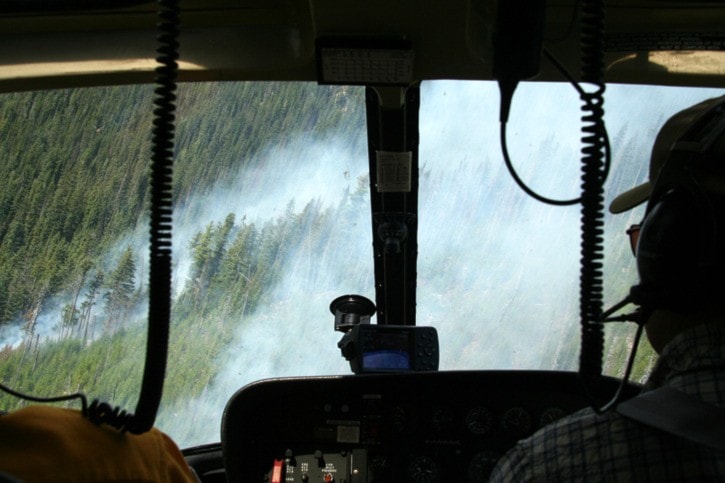How can letting a wildfire burn in Glacier National Park this year help protect the community of Revelstoke in a future severe wildfire season?
I jumped at an invitation from Parks Canada to do flyover of an ongoing Prairie Hills wildfire in the Beaver Valley area of Glacier National Park on Aug. 23.
Parks Canada fire management specialist Simon Hunt explained they're monitoring the fire instead of attacking it for several reasons.
"We have chosen to develop a monitoring strategy ... due to its location and the fact that it's been a mild fire season — with the long-term goal of risk reduction preventing future forest fires from burning out the backcountry of our park," Hunt said.
He explained if the fire grows, it will form a natural fire break that will impede future wildfires from travelling up the Beaver Valley towards the Trans-Canada Highway and CP Rail tracks.
Hunt said the monitoring strategy has been employed by Parks Canada for several years now. Before that, crews would seek to stop all fires.
Monitoring the fire doesn't mean doing nothing. The fire and weather conditions are monitored and firefighting contingency plans are put in place. If the fire approaches predetermined boundaries, crews will act.
Ecosystem health is another goal. Letting fires burn allows, "a natural process to occur that enables our ecosystem to function in a healthy way. The safety of people, facilities and surrounding land is our primanry mandate, but we also have a mandate for ecological integrity," Hunt said.
PHOTO GALLERY: Glacier National Park fire patrol with Parks Canada fire management specialist Simon Hunt. Photos by Aaron Orlando
How does the public — who are trained to call in when they spot a wildfire — react to the new management policies? "To date, perception has been very positive," Hunt said, adding they take the opportunity to inform callers about their new system.
The forests around Revelstoke, including the Mount Revelstoke and Glacier National Parks, are generally wetter than in other Interior forests. They usually dry out and burn later than in other places. In severe fire seasons, that means all firefighting resources are typically deployed when we need them here in late summer.
Having the new fire guard in place will assist firefighters in planning with limited equipment and personnel available. "Resources are always finite, there's never enough resources to be able to fight all the fires," Hunt said. "So, by creating strategic fire breaks in Glacier National Park we can focus our efforts on Mount Revelstoke and protecting the community during severe fire seasons."
The strategy can also save money. They save by not deploying resources to this fire, and by being able to better allocate resources in the future.
Hunt notes costs can add up quick. During the disastrous 2003 fire season, Parks Canada called in a giant Sikorsky helicopter to battle a blaze north of Mount Revelstoke from the city. It cost $100,000 just to get the helicopter and its crew here, and $10,000 an hour to operate.
Although weather can always shift, Hunt said the current fire poses "very low" risk to the highway given its location and the mild season.
***
Mobile users click here for video of the Parks Canada heli patrol over Glacier National Park.
Words, photos and video by Aaron Orlando, editor of the Revelstoke Times Review. @Aaron__Orlando
